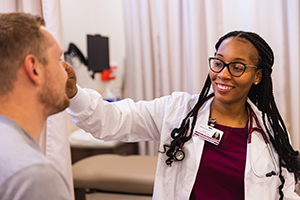The physician assistant career path: What is a PA?
Looking for a career in Health care? You’ve heard of doctors, nurses, X-ray technicians but have you considered becoming a physician assistant? The role of a physician assistant stands out as a promising option for students passionate about medicine but unsure about the lengthy commitment to become a doctor. If you are considering a future in healthcare, particularly as a PA, this guide will tell you what you need to know!
If you're interested in career helping others, becoming a physician assistant might be the right path for you.
What is a physician assistant?
 A physician assistant is a licensed medical professional who works alongside physicians to provide preventative, therapeutic and diagnostic healthcare services. PAs can practice in a wide variety of medical and surgical specialties, treating patients of all ages. With a unique blend of medical knowledge and interpersonal skills the options for PAs are diverse.
A physician assistant is a licensed medical professional who works alongside physicians to provide preventative, therapeutic and diagnostic healthcare services. PAs can practice in a wide variety of medical and surgical specialties, treating patients of all ages. With a unique blend of medical knowledge and interpersonal skills the options for PAs are diverse.
What does a physician assistant do?
The PA’s role is characterized by collaboration with physicians and other healthcare professionals. Some of their responsibilities include:
- Conducting physical exams.
- Diagnosing and treating illnesses.
- Ordering and interpreting tests.
- Counseling on preventative health care.
- Prescribing medications.
Physician assistants work with different levels of independence and frequently support physicians by helping in surgeries and overseeing patient care in medical facilities and hospitals. PAs day-to-day routine will look different depending on a variety of factors such as experience, specialty and the location that they work.
Physician assistant schooling
Physician’s assistant schooling involves a rigorous educational path that typically includes a combination of classroom instruction, laboratory work and clinical rotations where you work with actual patients. Here is what you can expect on the path to becoming a PA:
1. Bachelor’s Degree: Most PA programs require applicants to have completed a bachelor’s degree, preferably in a science-related field such as biology, chemistry or healthcare administration. However, some programs may accept students with degrees in other disciplines if they have completed prerequisite courses that include science and healthcare-related subjects.
2. Prerequisite Courses: Get ready for some lab work during your four years of bachelor’s studies. PA programs typically require that you complete specific prerequisite course in subjects such as anatomy, physiology, microbiology, chemistry and statistics. These courses provide the foundational knowledge that you will need to succeed in PA school.
3. PA Program: After completing a bachelor’s degree and prerequisite coursework, you must enroll in and complete a PA program accredited by the Accreditation Review Commission on Education for the Physician Assistant. These programs are typically classified as master’s degree programs. Expect this portion of your academic journey to take about two to three years.
4. Certification: Once you graduate from your PA program, you must pass the Physician Assistant National Certifying Examination administered by the National Commission on Certification of Physician Assistants. Passing the exam is required to become a certified PA and get your state licensure.
5. Continuing Education: To maintain certification, PAs must participate in ongoing continuing medical education activities and pass a recertification exam every ten years. This ensures that PAs stay up to date with advancements in medical knowledge and practice throughout their careers.
Becoming a physician assistant demands dedication and hard work. It involves committing to lifelong learning. However, if you’re passionate about healthcare and seeking a rewarding career with diverse options and responsibilities, the PA path can be an excellent choice for you!
Central Michigan University PA Program
Ready to start your academic journey and become a physician assistant? Central Michigan University offers a top-ranked Physician Assistant Program designed to equip students with the necessary skills, knowledge and experience to succeed in the healthcare field.
 Why should you consider CMU as a top contender for your PA studies?
Why should you consider CMU as a top contender for your PA studies?
- CMU PA students regularly score in the top 5-15 percent of the Physician Assistant National Certifying Exam PANCE.
- We ensure our students are prepared for success; our five-year first-time PANCE pass rate is 96 percent.
- You will have hands-on clinical experiences in a variety of fields.
- You will be a part of a program that focuses on teamwork and understands the value of mentorship from seasoned professionals in the field.
Physician assistant salary
Physician assistants enjoy competitive salaries, which reflects their hard work and important role in healthcare. According to the U.S. Bureau of Labor Statistics (BLS), the median wage for physician assistants was $126,010 per year or $60.58 per hour in 2022. Salaries can vary depending on factors such as location, experience, specialty and employer type.
Job outlook for PAs
Exciting news, there are no shortages of PA jobs in the near future! The demand for physician assistants continues to grow rapidly. According to the BLS, employment of physician assistants is projected to grow by 27 percent from 2022 to 2032, which is much faster than the average for all occupations.
Your future as a PA
The journey to becoming a physician assistant encompasses not only reaching your goals but also the meaningful experience and continual growth in knowledge. With programs like Central Michigan University’s Physician Assistant Program paving the way, and a job market that’s booming with opportunities, the path to becoming a PA is as exciting as it is fulfilling.
So, if you have a heart for healthcare and a desire to make a real difference, consider stepping onto the path of becoming a PA. Who knows? It could be the start of an incredible journey towards a career you’ll love.